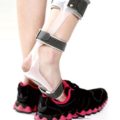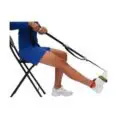*This page may contain affiliate links. When you buy through these links, we may earn a small commission at no extra cost to you.

We might have seen many in our day-to-day life using crutches for their mobility and movement, but we never spared a thought on their life’s struggles.
I understand; it’s universal that we don’t understand the pain unless we get into the same position as others and how they experienced it.
But now, when it’s time for you to get the help of crutches, so many questions strike your mind, but you feel blank as you don’t have an answer for them.
Some of the questions that you might have thought about are –
What are the different types of crutches? Which one would suit me best?
How to use them? What are the pros and cons accompanying them?
By the time you read this now, I pray to God that your dependence on crutches (whether for you or someone close to you) should be for a temporary time and not life-long.
Functions of A Crutch
The function of a crutch is to take off the weight pressure on your affected leg and provide broader base support for good balance.
It also helps you to reach places where you cannot go through a wheelchair with much ease.
Crutches also aid in good upright body movement, ensuring good blood circulation and optimum functioning of vital organs in the upper part of your body.
Before you use crutches, remember that strong arm and bone strength, along with good balance and coordination, are important for effective use of it.
What Are the Different Types of Crutches?
As such, there are many types of crutches now available in the market.
Some of the most common ones include:
1- Underarm crutches
Underarm crutches are also called auxiliary crutches.
You can buy these crutches at a nominal rate as per your custom size and specification.
Only two adjustments are to be made; one is the crutch’s height and the height of the handgrip.
Once it is done, you are all set to put it to use right away.
Modern-day crutches make use of rubber pads with a shock-absorbing feature to minimize the nerve and muscle damage underarm.
The wrong size will lead to many complexities.
So be wise in choosing the right one for your needs.
To be honest, for many people, when they think of crutches, they actually visualize this type first in their minds.
This can be used as the best support for all your leg injuries. These are made of wood or aluminum.
While holding your hand grip, make sure the elbow is at an angle of 30 degrees for good balance.
2- Forearm crutches
These crutches are also called elbow crutches or Lofstrand crutches, named after the person who invented them.
If you suffer from a polio attack or disablement of permanent nature, then this crutch is the perfect one for you.
As usual, the height of the handgrip and the crutch should be adjusted as per your needs, and then it is important to position the cuff one inch below your elbow level.
The cuff around your elbow will give more control and grip over the crutches and assist in easy movement.
They are easy to use on uneven floors.
But the disadvantage is that you may feel tired over a short period after using it.
3- Platform Crutches
This is almost similar to the underarm crutch.
The main difference is the support for the forearm by a metal pad with an adjustable strap and handgrip.
It is also called triceps crutches or arthritic crutches.
This is suitable for people suffering from arthritis or having trouble managing their weight and grip while moving.
4- Strutter Crutches
This is also a type of underarm crutch but comes with certain advancements for easy movement.
They use springs to absorb the weight pressure, and the crutch tips are large for even distribution of weight. They prevent nerve damage.
5- Bariatric Crutches
This is another type of underarm crutch but is mainly used by heavyweight people.
These are sturdy and strongly built with thick armpit pads and a latex hand grip to absorb heavy pressure.
6- Hands-free Crutches
With the advancement in technology, developments happen in crutch usage, taking into account the different past experiences.
So, they have come up with the idea of a hands-free crutch, which gives you complete freedom to use your hands normally like any other.
You have to rest your injured leg on a padded platform with a cushion, elevated at an angle of 90 degrees at the backside.
In short, this acts as a prosthetic leg for you. You can walk, go shopping, take kids, etc., without pain, stress, or fatigue.
Learn to embrace technological development, and it sure does come along with you in all walks of life.
How to Use Crutches for A Foot Injury Correctly?
You know that there is a first time for everything even though you didn’t wish this to happen in your life.
You have to take your bold step forward to progress from one place to another and in your life.
Initially, you will find it different and difficult to move using crutches.
So, it is wise to seek the help of others until you gain complete confidence.
Put weight on the healthy leg and move the corresponding crutch forward to a point till which you can maintain a balance.
Then shift it to the opposite arm holding the crutch and move it forward and repeat the process.
While swinging, your arm withstands a weight of one to three times your body weight.
For support, make use of the handgrips and don’t support on armpits; this will cause pain in that area.
Always position the crutches only a few inches in front of you. Don’t walk fast, and never try to take big steps using crutches.
Ask anyone to assist you while going through the stairs.
In the case of walking downstairs, put your crutches on the lower step and then go down with the good leg.
In the case of upstairs, take your good leg forward and then put your crutches on the upper step.
If you happen to use only one crutch, then you need to move the weaker leg, and the crutch held under the arm corresponding to your stronger leg forward first and then move your stronger leg.
The conclusion
No matter what kind of crutches you choose for your mobility, it’s important that you take time, practice, and learn to walk with them.
If not, these can be dangerous and can cause you greater harm than good.
- different types of crutches
- types of crutches
- different types of crutches strosberg






